Many learners find Polish verbs of motion to be one of the most confusing aspects of the language. And no wonder: to use them correctly, you need to pay attention to a bunch of distinctions that do not even exist in English. Let’s try to make them less scary by analyzing some of their defining features.
Polish has several commonly used verbs of motion. They have different meanings, but in terms of grammar, they all work pretty much the same. To make things easier for you, we’ll start by discussing just the two most common verbs of motion. Later on, we’ll take a brief look at the remaining ones.
Polish verbs of motion iść and jechać
Iść and jechać – by far the most used verbs of motion – are both translated as “to go”, but they mean quite different things. This is because Polish has separate verbs for “going” depending on the means of transport used.
Iść means simply to go on foot or to walk.
Jechać means to go by vehicle. This includes all types of land transport (car, bike, train, skateboard, horse), but not water or air transport (plane, boat). It doesn’t matter if you’re actually steering the vehicle (in which case it is translated as to drive or to ride) or just traveling as a passenger.
Aspects: the basics
All Polish verbs belong to one of two classes: perfective or imperfective. These are known as grammatical aspects.
- Perfective verbs describe actions that have a clearly defined beginning and end. In other words, actions that have clearly been completed in the past, or will be completed in the future.
- Imperfective verbs describe actions without any reference to their completion. We know that they have a beginning, but we don’t know anything about the end.
One of the reasons why Polish verbs of motion are so challenging is that they add another layer to this already complex system.
Imperfective verbs of motion differ from all other Polish verbs in that they have two sub-classes:
- Indeterminate verbs describe motion that is done regularly, habitually, or without a specific direction.
- Determinate verbs refer to motion that happens only once, mostly with a specific direction.
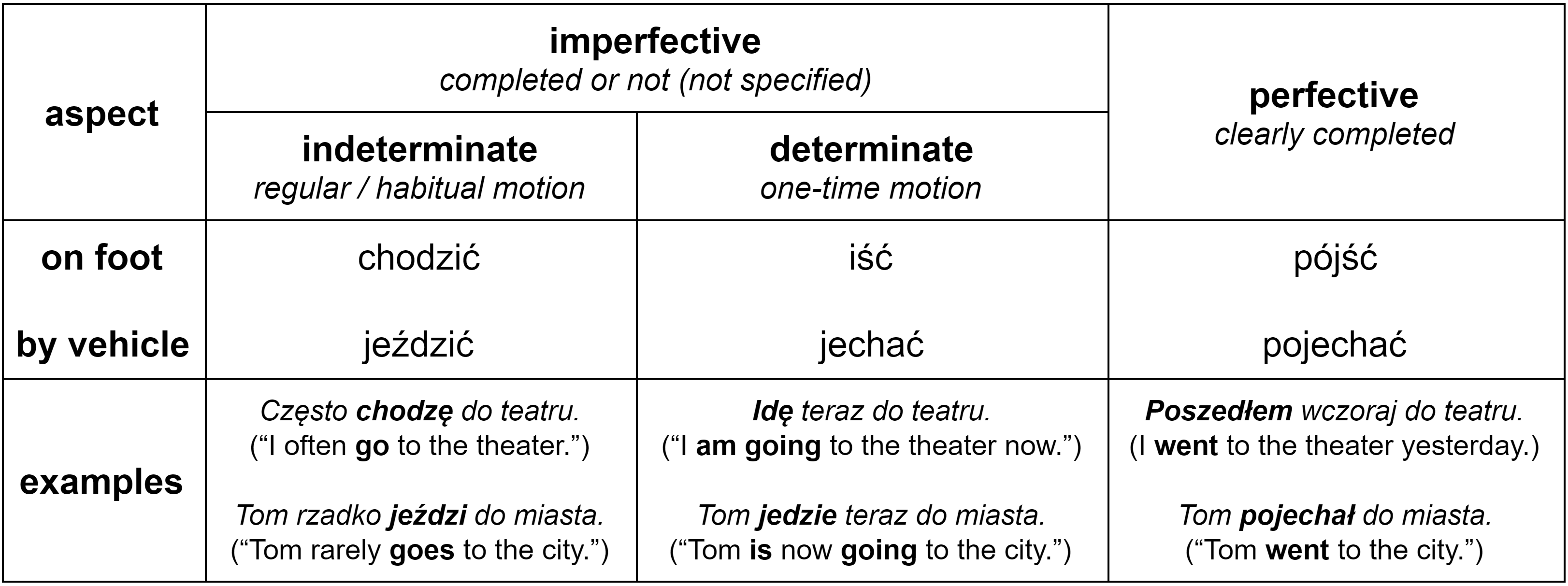
Now that we’ve laid down the basics, it’s time to back up the theory with specific examples.
Our goal is to view this complex topic from as many perspectives as possible. So first, we’ll try to understand all individual grammatical aspects, and later we’ll take a look at how they behave in specific tenses (past, present, and future).
The imperfective indeterminate aspect
The imperfective indeterminate verbs of motion chodzić and jeździć are used to talk about habits or repetitive actions, as well as to generalize:
Julia chodziła kiedyś na siłownię. (“Julia used to go to the gym.”)
Dlaczego nigdy nie jeździsz do pracy autobusem? (“Why do you never go to work by bus?”)
They are also used to talk about motion that doesn’t have a single specific direction – even if it only happens once:
Tom chodzi po lesie. (“Tom is walking in the forest.”)
Będziesz jeździła konno? (“Will you be riding a horse?”)
The imperfective determinate aspect
The imperfective determinate verbs of motion iść and jechać are used to refer to one-time, continuous motion, often with a specific goal:
Idę do sklepu. Chcesz coś? (“I am going to the store. Do you want anything?”)
Szedł powoli, rozmawiając przez telefon. (“He was walking slowly as he was talking on the phone.”)
Dlaczego jedziesz tak szybko? Mamy jeszcze dużo czasu. (“Why are you driving so fast? We’ve got plenty of time to spare.”)
Jechaliśmy tu pięć godzin. (“We drove for five hours to get here.”)
The perfective aspect
The perfective verbs of motion pójść and pojechać are used to express motion with a clear indication of its completion:
Pójdziesz za mną na imprezę? (“Will you go to the party with me?”)
Adam poszedł do sklepu, wróci za pół godziny. (“Adam went to the store, he will be back in half an hour.”)
Pojechałem do Krakowa pociągiem. (“I went to Kraków by train.”)
Anna pojedzie tam rowerem. (“Anna will go there on her bike.”)
Polish verbs of motion in the present tense
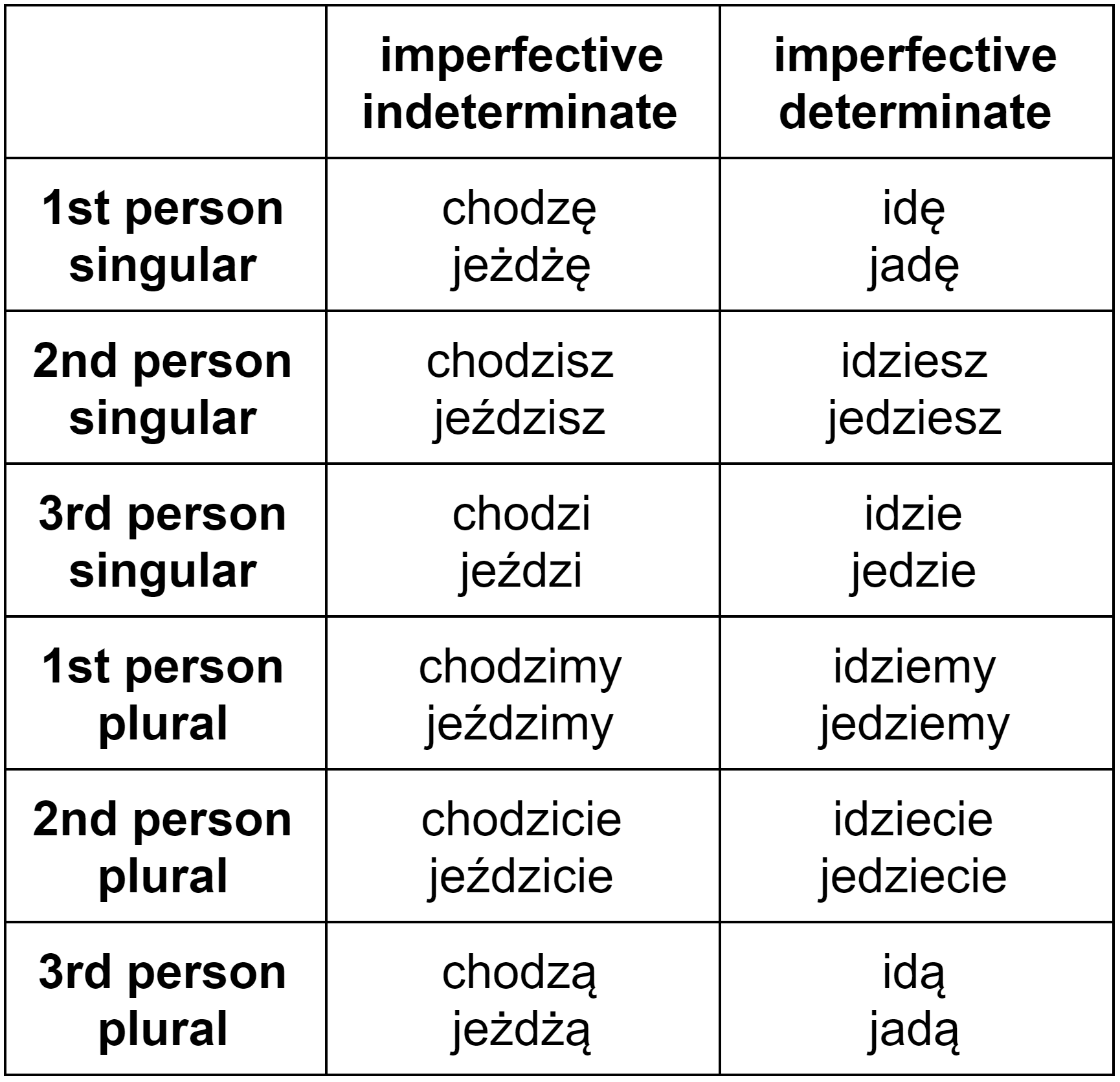
The present tense is probably the easiest of them all. Only two aspects are possible here, and the number of verb forms is relatively low. Still, there are some quirks you should be aware of.
Present tense is the only tense that doesn’t allow for the perfective aspect. The perfective aspect emphasizes completion, and no matter how you look at it, you can never say that completion is “happening” right now. So when you’re talking about an action, it has either already been completed in the past, or will be completed in the future.
That leaves us with the imperfective indeterminate and imperfective determinate aspects.
Present tense: imperfective indeterminate
The imperfective indeterminate aspect is used to talk about habitual and repetitive motion, which is why it is the only aspect in which Polish verbs of motion can be used together with adverbs of frequency.
These tend to appear with present tense verbs and include zawsze (“always”), często (“often”), czasami (“sometimes”), rzadko (“rarely”), and nigdy (“never”):
Jak często chodzisz do kina? (“How often do you go to the movie theater?”)
Bardzo rzadko jeżdżę pociągiem. (“I hardly ever travel by train.”)
They can also accompany more specific expressions of time that indicate some kind of regularity:
Anna chodzi na fitness w każdy wtorek i czwartek. (“Anna goes to fitness classes every Tuesday and Thursday.”)
Raz w miesiącu jeżdżę do Warszawy. (“I go to Warsaw once a month.”)
As you’ve probably noticed, this aspect mostly corresponds to the present simple tense in English. However, you can also use it to talk about motion that doesn’t have any specific direction, in which case it can also be translated into the present continuous tense:
Chodzę po centrum handlowym. (“I am walking around the mall.”)
Jeździmy teraz na deskorolkach. (“We are riding skateboards right now.”)
Present tense: imperfective determinate
The imperfective determinate verbs iść and jechać are mostly used to talk about continuous motion that is happening right now:
Idziemy do restauracji. Idziesz z nami? (“We are going to the restaurant. Are you going with us?”)
Nie mogę teraz rozmawiać, jadę samochodem. (“I can’t talk right now, I am driving.”)
This aspect in the present tense is also used to talk about the future. Actually, this is the most common way to talk about future plans or scheduled events:
Mama idzie jutro do lekarza. (“Mom is going to the doctor’s tomorrow.”)
W przyszłym tygodniu jadę do Berlina. (“I am going to Berlin next week.”)
This aspect typically corresponds to the English present continuous tense.
Polish verbs of motion in the past tense

Don’t let the above table scare you. Polish verbs in the past tense take different forms depending on the gender of the subject performing the action – that’s why there are almost five times as many possible forms as in the present tense.
Sure, it’s a lot to process. Some of the forms don’t even resemble the infinitive verb (iść → szedł etc.). Luckily, the rules governing their use are pretty intuitive.
Past tense: imperfective indeterminate
The imperfective indeterminate verbs in the past tense are used to talk about repetitive or habitual motion that took place in the past. They sometimes go together with adverbs of frequency:
Gdy byli młodzi, często jeździli w góry. (“When they were young, they often went to the mountains.”)
Po pracy chodziliśmy na piwo. (“We used to go out for a beer after work.”)
Tamtego lata jeździłem do szpitala prawie każdego tygodnia. (“That summer I was going to the hospital almost every week.”)
Just as in the present tense, the imperfective indeterminate aspect can refer to movement without any specific direction:
Tom chodził po mieście przez dwie godziny. (“Tom walked around the city for two hours.”)
Depending on the context, these can be translated in several ways. Probably the most common translations are past simple and used to + verb, but past continuous is also possible in some cases.
Past tense: imperfective determinate
The imperfective determinate aspect in the past tense typically describes one-time directed movement that may or may not have been brought to completion. It is often used when viewing the motion from the perspective of the time when it was happening:
Gdy szedłem do domu, spotkałem Marka. (“As I was walking home, I met Marek.”)
Szła po chodniku i jadła jabłko. (“She was walking on the sidewalk and eating an apple.”)
Wiem, że jechałem za szybko. (“I know that I was driving too fast.”)
Jechał do pracy rowerem, gdy to się zdarzyło. (“He was biking to work when this happened.”)
As you can see in the examples, these will usually correspond to the present continuous tense in English.
Past tense: perfective
If you take a look at the table at the beginning of the section, you will quickly realize that perfective forms are created by adding the prefix po- to the imperfective determinate forms.
This po– prefix is a marker of completion: if you say szedłem, it’s unclear if you managed to reach your destination, whereas saying poszedłem makes it obvious that you did eventually get there.
Here are a few typical use cases – each makes it clear that the motion was completed:
O której poszliście do domu? (“At what time did you go home?”)
Poszedłem tam z ciekawości. (“I went there out of curiosity.”)
Pojechali do centrum autobusem. (“They went downtown on a bus.”)
Marii nie ma w domu, pojechała odwiedzić swoich rodziców. (“Maria isn’t home, she went to visit her parents.”)
In most cases, the perfective aspect in the past will translate into the past simple tense in English.
Polish verbs of motion in the future tense
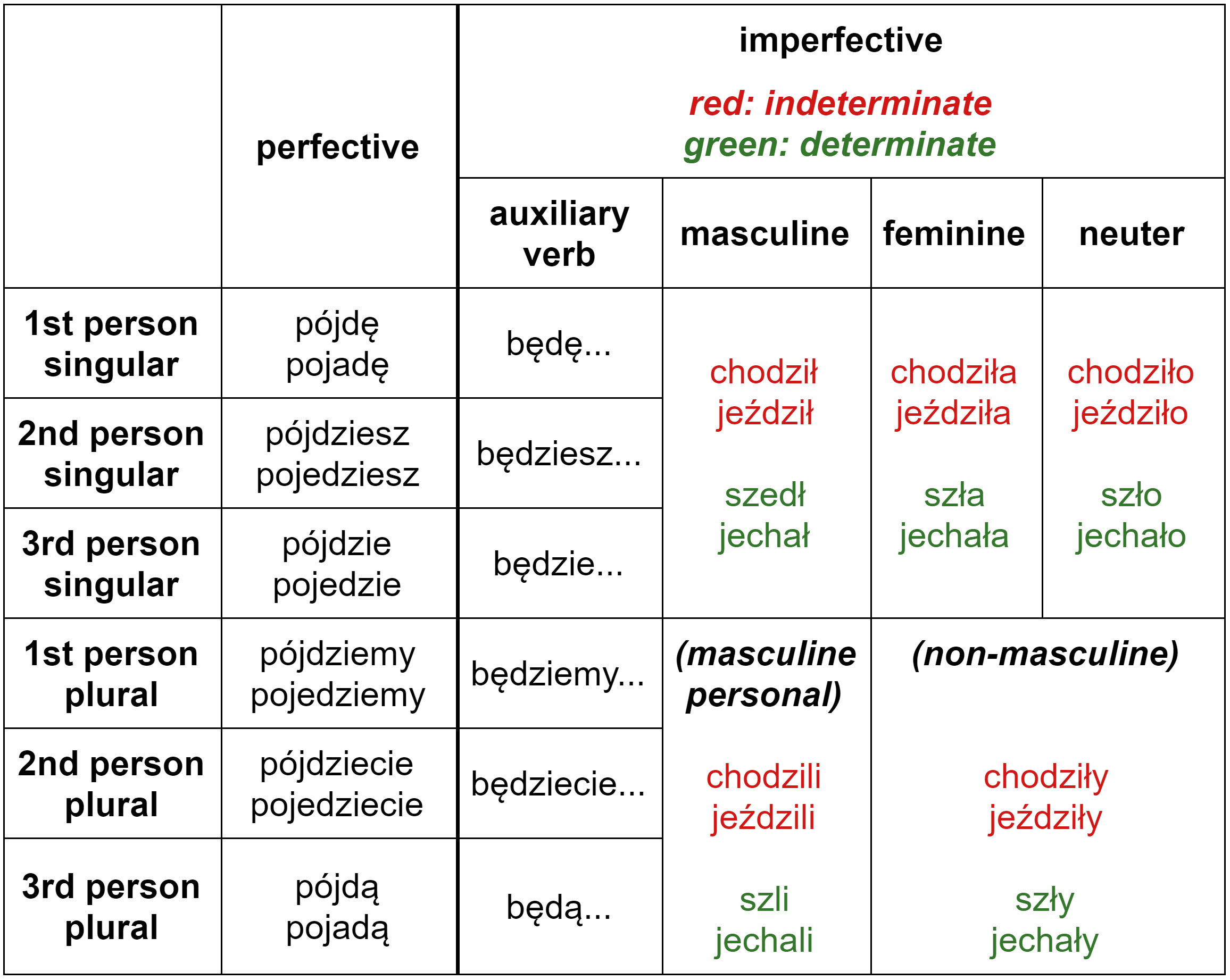
Once again, the complete conjugation looks much more complicated than it actually is. Let’s break it down aspect-by-aspect.
Future tense: perfective
The perfective verb forms are actually created in a quite straightforward way: you just add the perfective prefix po- to imperfective indeterminate present tense forms and change the initial i into j, while also changing the o into ó in the case of pójść.
The perfective aspect in the future tense is used to refer to one-time motion that will be started and completed in the future:
Pójdę tam o dziesiątej rano. (“I will go there at 10 AM.”)
Nie wiem, czy ona pójdzie z nami. (“I don’t know if she will go with us.”)
Kto pojedzie tam zamiast ciebie? (“Who will go there instead of you?”)
W przyszłym roku pojedziemy do Francji, obiecuję. (“Next year we will go to France, I promise.”)
As it should be evident from the examples, the perfective future forms usually correspond to the future simple tense in English.
Future tense: imperfective indeterminate
The imperfective determinate verbs in the future are made up of the auxiliary verb być (“to be”) followed by verb forms that are “borrowed” from their past tense counterparts.
The “borrowed” verb forms are always third person forms (chodził, chodziła, etc.) for each of the genders. Thus, a man would say będę chodził, while a woman would use będę chodziła instead.
Meanwhile, the form of the auxiliary być conveys information about the grammatical person. It’s only by looking at the auxiliary verb that you can distinguish the first person masculine form będę chodził from the third person masculine form będzie chodził.
Just as in the past and present tense, the imperfective indeterminate aspect refers to motion that happens habitually or regularly – only this time in the future. Here are some examples:
Od dziś będę chodził na basen w każdy piątek. (“Starting today, I will be going to the swimming pool every Friday.”)
Kto będzie jeździł po zakupy, gdy mnie nie będzie? (“Who will be driving to do the shopping when I’m away?”)
Note that apart from the past tense indeterminate forms (like chodził), the auxiliary “być” can also be followed by the infinitive form (chodzić). In this case, there is no gender distinction, so “będę chodzić” can be used by people of both genders:
W grudniu będę chodzić na jogę. (“In December I will be going to yoga classes.”)
The imperfective indeterminate typically corresponds to the English future continuous or future simple tense.
Future tense: imperfective determinate
As far as conjugation is concerned, the imperfective determinate aspect in the future tense works similarly to the imperfective indeterminate aspect described above – it “borrows” the past tense imperfective determinate forms and adds the auxiliary verb być in front of them.
This aspect used to talk about motion which will happen in the future without any emphasis on whether it’ll be completed or not. The only thing it gives away is that the motion will start and last for some time:
Kupię mleko, gdy będę szedł do domu. (“I will buy milk when I will be going home.”)
Zadzwoń, gdy będziesz jechał do miasta. (“Call me when you will be going to the city.”)
Like in imperfective indeterminate verbs, replacing the gender-specific past tense form with a gender neutral infinitive is a perfectly grammatical way to use a determinate verb of motion in the future tense:
Marek będzie zaraz szedł do biura. (“Marek will be going to the office in a moment.”)
This aspect mostly translates into the English future continuous tense, and sometimes into the future simple.
Prefixed verbs of motion in Polish
Adding the prefix po- might be the most common way of creating perfective forms of verbs of motion, but it doesn’t mean it’s the only one.
There are about a dozen of prefixes which can be added to Polish verbs of motion. Prefixed verbs such as dojechać are often considered to be completely separate words, but the fact is that they are all derived from more basic verbs like jechać.
As it should be evident from the rough translations in the table below, adding a prefix can completely change the meaning of the verb.
Each of these prefixed verbs can occur in two variants: perfective and imperfective. As you already know, the perfective variants are used to talk about motion that is clearly brought to completion, while the imperfective ones do not specify whether the action was completed or not.
All prefixed verbs conjugate just like the regular ones, the only difference being the added prefix.
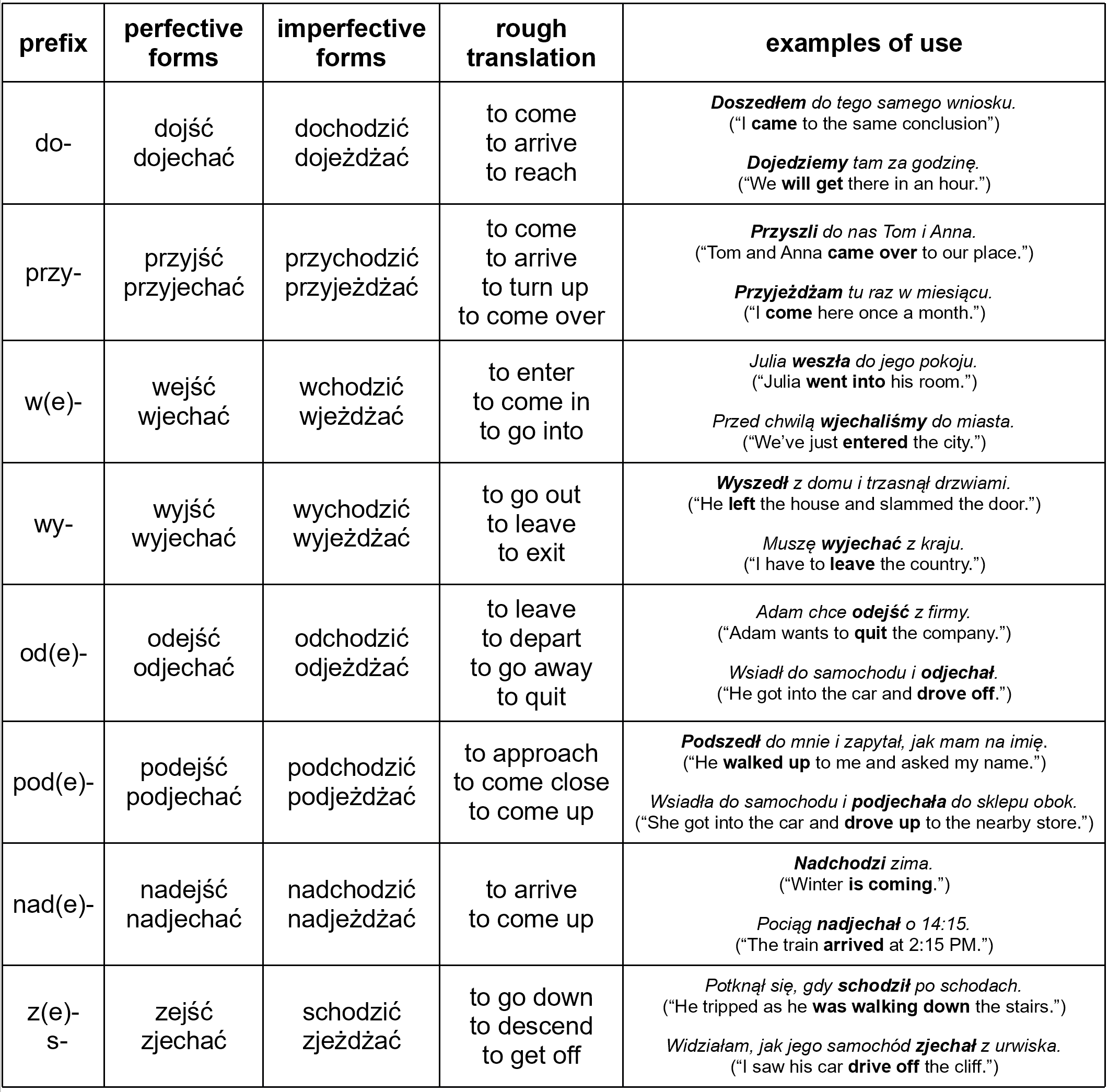
Prepositions and grammatical case
Polish verbs of motion tend to occur together with certain prepositions. The three prepositions you’re most likely to encounter in this context are do (“to”), na (“to”), and z (“from”).
The preposition do is the most common means of expressing the goal of motion, just like the English “to”. It always requires the following phrase to take the genitive case:
Chodzę do kościoła w każdą niedzielę. (“I go to church every Sunday.”)
The preposition na, which usually corresponds to the English “on”, can also mean “to”, but it is only used this way with a limited set of nouns. Most of them (though not all) are wide, open spaces. These include basen (“swimming pool”), lotnisko (“airport”), cmentarz (“cemetery”), stadion (“stadium”), and rynek (“marketplace”).
The goal of motion after the preposition na must take the accusative case:
Idziemy na basen. (“We’re going to the swimming pool.”)
When used together with a verb of motion, the preposition z will usually mean “from” – its main purpose is expressing the source of motion. The source itself must be put in the genitive case:
Ten pociąg jedzie z Krakowa do Warszawy. (“This train runs from Kraków to Warsaw.”)
(If you’d like to learn more about do, na, z, and other prepositions, this post discusses Polish prepositions in much more detail.)
Expressing means of transport
There are two major ways of specifying the means of transport by which the movement takes place.
The more common one is putting the means of transport in the instrumental case without any additional preposition. This mainly applies to vehicles and roughly corresponds to how the preposition “by” is used in English:
Przyjechałam tu samochodem. (“I came here by car.”)
Jedziemy do Francji pociągiem. (“We’re going to France by train.”)
Another way of talking about the means of transport is using the preposition na or w followed by the locative case. However, it only works with some means of transport – mostly those which you can “ride” in English:
Kto jeździ na tym koniu? (“Who rides this horse?”)
Tom jeździ teraz na rowerze. (“Tom is riding his bike now.”)
Lastly, if the movement is done on foot, this is expressed by adding the adverb pieszo (or piechotą):
Chodzisz do szkoły pieszo? (“Do you go to school on foot?”)
Idiomatic expressions with “iść” and “chodzić”
Just like the verb “to go” in English, the Polish verbs iść and chodzić are sometimes used in ways that have little to do with physical motion. Here are some examples of common idiomatic expressions employing these verbs:
Idę spać. (“I am going to sleep.”)
Adam nie chodzi na żadne wykłady. (“Adam doesn’t attend any lectures.”)
Jak idzie praca? (“How is the work going?”)
Czy Mary chodzi z Tomem? (“Is Mary going out with Tom?”)
Nie wierzę, że do tego doszło. (“I can’t believe it has come to this.”)
Jeśli wszystko pójdzie dobrze, jutro będziemy już w domu. (“If everything goes well, we’ll be home tomorrow.”)
Nie wiem, o co ci chodzi. (“I don’t know what you mean.”)
O co chodzi w tym filmie? (“What is this movie about?”)
Other Polish verbs of motion
Of course, iść and jechać are not the only verbs of motion in Polish – there is a bunch of other verbs that work the same way, complete with imperfective indeterminate, determinate, and perfective variants.
Nearly everything that has been said here about iść and jechać will apply to those other verbs as well. They all have pretty straightforward English equivalents, as they refer to rather specific types of motion.
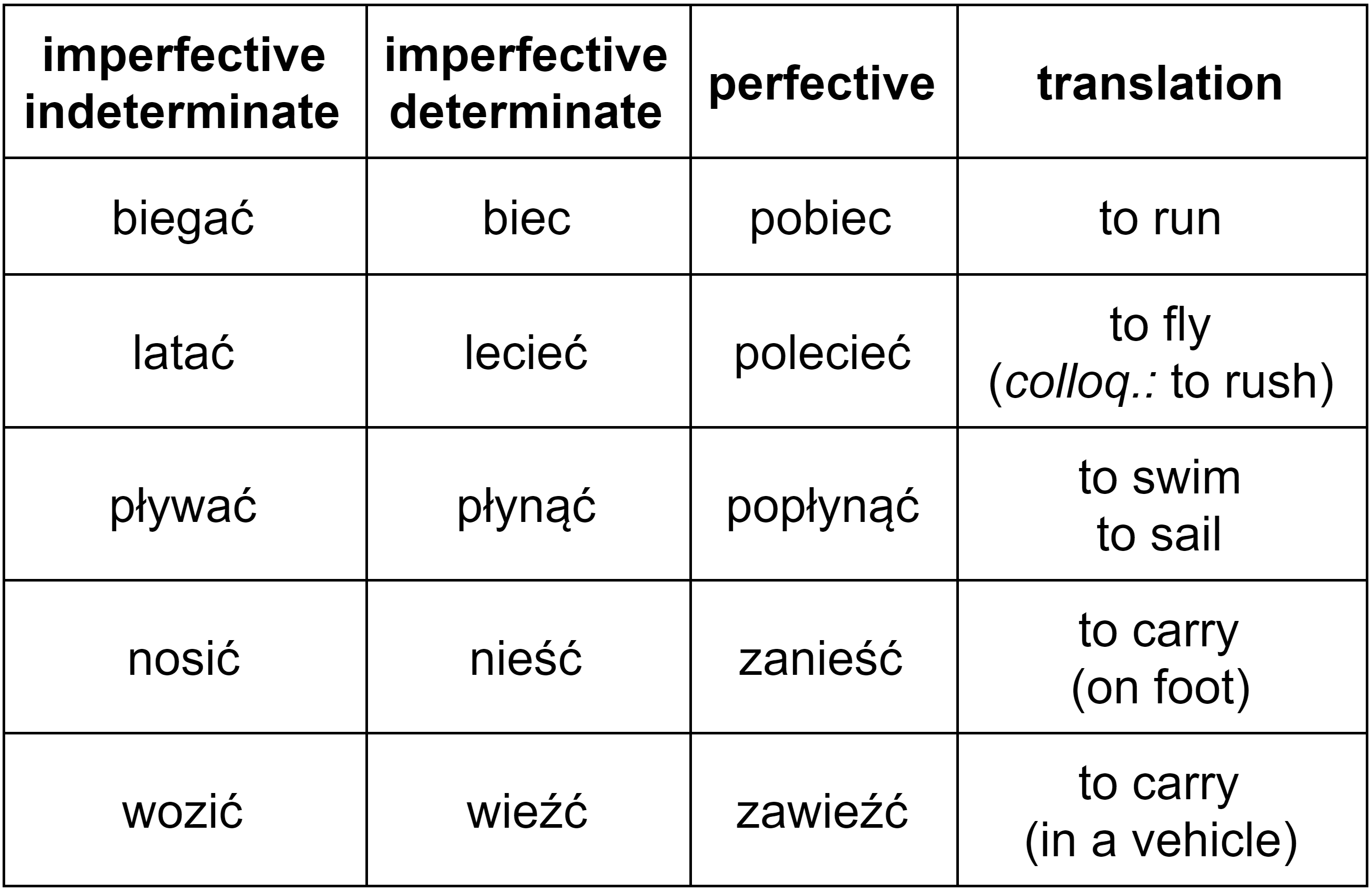
The Polish Verbs of Motion Grammar Challenge
Mastering Polish verbs of motion is likely one of the toughest challenges you’ll face when learning the language. Hopefully, this article has made it all a bit less intimidating.
If you’d like to test your skills in actual sentences, we’ve got you covered. The Polish Verbs of Motion Grammar Challenge will let you practice using all verbs of motion discussed in this article so that you can get a more intuitive grasp of all the diverse forms.


Thanks a ton, its exactly what ive been looking for. Hope to find more charts like the one about prefixes and verbs up there. 👍
That was really helpful – thanks a bunch!
Pingback: The Definitive Guide to Learning Polish - Clozemaster Blog
Great article, great charts and really well explained. It will help me a lot on Clozemaster. Polish verbs of motion are probably the most challenging thing for me on Clozemaster but with lot of repetition, they do eventually sink in 🙂
An excellent and thorough explanation of verbs of motion and their prefixes. I have been looking for a long time for an explanstion like this, the clarity is outstanding . Better than my Polish grammar books.
Great article! Can you just fix up the table with the past tense determinate and indeterminate labels, you have written “Imperfective Determinate” twice and it’s confusing.
Thanks for pointing this out! I updated the table, should be fine now.
Very good explanation and so helpful in my Polish language studies. Thank you so much!
It is gold.. Thanks a lot
Thank you so much, your explanations are fantastic!! Am learning Polish and have been struggling with how to properly use these verbs forever and a day – thus so glad I came across this site!